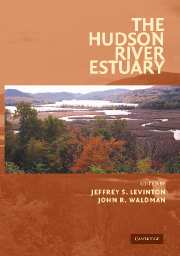Book contents
- Frontmatter
- Contents
- Preface
- List of Contributors
- The Hudson River Estuary
- 1 The Hudson River Estuary: Executive Summary
- GEOLOGICAL, PHYSICAL, AND CHEMICAL SETTING OF THE HUDSON
- 2 The Hudson River Valley: Geological History, Landforms, and Resources
- 3 The Physical Oceanography Processes in the Hudson River Estuary
- 4 Sedimentary Processes in the Hudson River Estuary
- 5 Benthic Habitat Mapping in the Hudson River Estuary
- 6 Reconstructing Sediment Chronologies in the Hudson River Estuary
- 7 Major Ion Geochemistry and Drinking Water Supply Issues in the Hudson River Basin
- PRIMARY PRODUCTION, MICROBIAL DYNAMICS, AND NUTRIENT DYNAMICS OF THE HUDSON
- HUDSON RIVER COMMUNITIES, FOOD WEBS, AND FISHERIES
- CONTAMINANTS AND MANAGEMENT ISSUES OF THE HUDSON RIVER ESTUARY
- Index
- Plate section
- References
2 - The Hudson River Valley: Geological History, Landforms, and Resources
Published online by Cambridge University Press: 06 January 2010
- Frontmatter
- Contents
- Preface
- List of Contributors
- The Hudson River Estuary
- 1 The Hudson River Estuary: Executive Summary
- GEOLOGICAL, PHYSICAL, AND CHEMICAL SETTING OF THE HUDSON
- 2 The Hudson River Valley: Geological History, Landforms, and Resources
- 3 The Physical Oceanography Processes in the Hudson River Estuary
- 4 Sedimentary Processes in the Hudson River Estuary
- 5 Benthic Habitat Mapping in the Hudson River Estuary
- 6 Reconstructing Sediment Chronologies in the Hudson River Estuary
- 7 Major Ion Geochemistry and Drinking Water Supply Issues in the Hudson River Basin
- PRIMARY PRODUCTION, MICROBIAL DYNAMICS, AND NUTRIENT DYNAMICS OF THE HUDSON
- HUDSON RIVER COMMUNITIES, FOOD WEBS, AND FISHERIES
- CONTAMINANTS AND MANAGEMENT ISSUES OF THE HUDSON RIVER ESTUARY
- Index
- Plate section
- References
Summary
abstract The course and character of the Hudson reflect its underlying geological structure and the modifications of Pleistocene glaciations. Radiating drainage out of the Adirondacks is transformed into a broad meandering pattern in its tidal reaches below Troy. The river's course then cuts through the Hudson Highlands in a fjord-like gorge. A broad curving path takes the river along the Triassic, Palisades Escarpment following the juncture with the older rocks of Manhattan. The bedrock foundation of the Hudson was established in three mountain-building episodes beginning over a billion years ago. Most recently, the entire region has been glaciated and the course of the Hudson takes it through relic beds of glacial lakes and several ice margin deposits of glacial sediment. After the deglaciation of the region, estuarine conditions were established in the Hudson beginning about 12,000 years ago. The Hudson briefly crosses the coastal plain breaching the Wisconsin terminal moraine at the Narrows. On the continental shelf, the course of the ancestral Hudson is marked by the Hudson Submarine Canyon.
Introduction
The source of the Hudson River was discovered in 1872 by the naturalist and surveyor, Verplanck Colvin. It is a pond on the western slope of Mt. Marcy, the highest peak in the Adirondacks at 1,629 m. Colvin, an ardent supporter of preserving the mountain forests and watershed, referred to the pond as ‘tear of the clouds’ (Schneider, 1997).
- Type
- Chapter
- Information
- The Hudson River Estuary , pp. 13 - 23Publisher: Cambridge University PressPrint publication year: 2006
References
- 3
- Cited by

